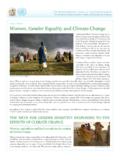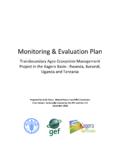Transcription of Rural Development - United Nations
1 Rural Development Rural areas are facing major challenges today which arise mainly from globalisation, demographic change and the Rural migration of young, well-trained people. Policies for Rural areas aim to contribute to recognising and making use of strengths and opportunities. Background With its Rural policies Germany aims to ensure that the infrastructural prerequisites for decent living conditions in Rural areas are fulfilled and that existing and new potentials are developed through economic Development . Environmental concerns are also considered and integrated during the planning phase of programmes of measures to support Rural areas. A large share of policies targeted at land use in Rural areas serves to promote agrobiodiversity and environmental measures in agriculture.
2 Access to services and infrastructure is generally available nationwide in Germany (drinking water supply, sewage treatment, mail, telecommunications, transport). The quality of these services, however, differs from region to region. One field which needs improvement is sewage treatment where, for economic reasons, the number of decentralised systems is growing. The call for nationwide access to broadband in the field of IT and telecommunications creates new challenges. Furthermore, employment opportunities are not always sufficiently available in Rural regions. The German government is taking various measures to improve the situation. Integrated Rural Development Rural Development is also a European concern. At EU level, it was not until after the reform of the EU's structural policy in 1988 that a gradual but lasting change in the perception of Rural areas occurred during the early 90s.
3 Before, during the 1950s, the supranational efforts to ensure security of supply for European citizens and, therefore, agricultural production were priorities when the Common Agricultural Policy (CAP). was developed. Already during the early 1960s, however, security of supply was achieved and the production of the most important agricultural goods showed a constant structural surplus. In addition, as a consequence of structural change, small scale and extensive agriculture disappeared. The migration of the Rural working age population led to economic and social decline, in particular in border and mountain regions, on islands and in other remote regions. These adverse developments triggered the change in the perception of Rural areas. With its Communication on The Future of Rural Society and the subsequent reform of the Common Agricultural Policy, the Commission gave an impetus at the European level for problem solving strategies going beyond policies which solely focused on the agricultural sector.
4 Another reform of the CAP in 1999, the Agenda 2000, introduced a distinction between policy areas of the first pillar of the CAP (including traditional export subsidies, market intervention and direct payments) and the second pillar, the Development of Rural areas. During the funding period 2007-2013 Rural Development will be co-financed with about 10% of the CAP budget through the European Agricultural Fund for Rural Development (EAFRD), which was expressly created for this purpose. Compared to total EU. expenditure for agriculture and regional Development , however, this share is still very small. The introduction of a specific category "Policies for Rural areas" cannot belie that these policies still mainly consist of support measures targeting agriculture and forestry and are motivated by agricultural policy considerations.
5 Furthermore, in most EU Member States and at EU level the responsibilities for this sector remain under the traditional roof of agricultural policy. To sum up, regardless of where the competences for this sector lie, Rural Development is much more than developing agriculture. According to the OECD, for example, agriculture "is no longer the backbone of Rural economies." 1 Agricultural policies so far have focused on support for farms and other agricultural facilities. Despite major subsidies, these policies did not succeed in triggering or improving Rural Development . 2. Therefore, the OECD calls for a rethinking and champions integrated approaches in a "new Rural paradigm". The two main characteristics of this paradigm are: "1) a focus on places instead of sectors; and 2) a focus on investments instead of subsidies.
6 " 3. Model project "Active Regions Shaping Rural Futures": a contribution to further advancing integrated Rural Development Background to the "Active Regions" project 4. The model and demonstration project "Active Regions Shaping Rural Futures" was launched in the form of a nationwide contest by the German Government in 2001. The contest addressed regions which would, as a model, implement approaches to the four aims of consumer focus, nature-friendly and environmentally compatible agriculture, strengthening Rural areas and creating additional sources of income and fostering Rural -urban connections. Taking the above-mentioned goals into consideration, interest groups of the regions had to create regional partnership networks and draw up an integrated regional Development plan (REK) based on the specific strengths, weaknesses and potentials of their region.
7 1. OECD 2006. Rural Policy Reviews. The New Rural Paradigm. POLICIES AND GOVERNANCE, p. 41. 2 OECD 2006. Rural Policy Reviews. The New Rural Paradigm. POLICIES AND GOVERNANCE, p. 22. 3 OECD 2006. Rural Policy Reviews. The New Rural Paradigm. POLICIES AND GOVERNANCE, p. 60. 4 See also At first the "Active Regions" project period was limited to the end of 2005. However, the project was then updated with regard to contents and extended to late 2007. The new element of the "Active Regions" steering approach is the consequent shift in the four pillars of steering and responsibility and the obligations this entails for the 18. model regions with regard to: processes: regional partnership network as central decision-making body and the responsible regional management body as central service-provider of the region.
8 Contents: steered by objectives and evaluation and the regional partnership networks choosing the projects;. finance: regional budgets support integrated projects;. administration: partner for implementation at local level, reviews financial and technical requirements. The findings of recent regional research were incorporated into the "Active Regions". steering approach. Firstly, it has been realised that integrated regional Development cannot be induced from the outside or top-down but rather has to make use of the potentials of a region itself, which lie in the respective geographical, economic and social conditions. Secondly, the approach follows the results of discussions on regional governance, which points to the importance of regional cooperation and also the need to manage regional affairs and provide political guidance at the regional level.
9 Regional governance considers a region as part of a multi-level political system and recommends steering developments through binding objectives and competition as opportunities for innovative regional policies. Results The aim of "Active Regions" was creating and strengthening regional partnership networks for an integrated Rural Development in selected model regions. These aims were to be achieved by applying the five principles of regionality, partnership, reflexivity, integration and competition and their respective implementation tools. This steering approach has proven successful. Although this approach was more time-consuming owing to the necessary harmonisation and coordination in particular within the model regions, it was widely accepted by the respective regions and at programme level.
10 It was also possible to show that supporting soft measures can lead to hard effects by initiating chains of effect through the impetus provided by support. It becomes obvious that the approach of consequently shifting responsibility for a share of support measures to the regional level has paid off. Accordingly, it is recommended to support Rural Development in principle by means of regional-specific support programmes in future. The ex-post analysis of hard effects in late 2005 revealed that a total of 1,464 jobs (full- time equivalent) can be attributed to effects of "Active Regions". 763 of these jobs were newly created and 701 jobs could be secured. Furthermore, direct follow-up investments of EUR 83 million were generated, EUR 57 million of which came from private sources.











